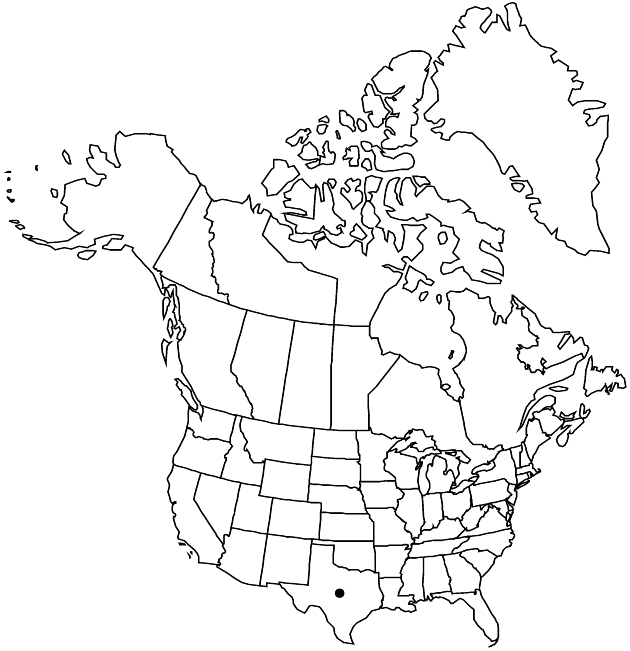Difference between revisions of "Perityle angustifolia"
SouthW. Naturalist 4: 204. 1959.
FNA>Volume Importer |
imported>Volume Importer |
||
| (6 intermediate revisions by 2 users not shown) | |||
| Line 8: | Line 8: | ||
}} | }} | ||
|common_names=Narrow-leaved rock daisy | |common_names=Narrow-leaved rock daisy | ||
| − | |basionyms={{Treatment/ID/ | + | |special_status={{Treatment/ID/Special_status |
| + | |code=E | ||
| + | |label=Endemic | ||
| + | }} | ||
| + | |basionyms={{Treatment/ID/Basionym | ||
|name=Laphamia angustifolia | |name=Laphamia angustifolia | ||
|authority=A. Gray | |authority=A. Gray | ||
| + | |rank=species | ||
| + | |publication_title=Smithsonian Contr. Knowl. | ||
| + | |publication_place=3(5): 100. 1852 | ||
}} | }} | ||
|synonyms={{Treatment/ID/Synonym | |synonyms={{Treatment/ID/Synonym | ||
|name=Laphamia angustifolia subsp. laciniata | |name=Laphamia angustifolia subsp. laciniata | ||
|authority=(A. Gray) W. E. Niles | |authority=(A. Gray) W. E. Niles | ||
| + | |rank=subspecies | ||
}} | }} | ||
|hierarchy=Asteraceae;Asteraceae tribe Heliantheae;Asteraceae (tribe Heliantheae) subtribe Peritylinae;Perityle;Perityle sect. Laphamia;Perityle angustifolia | |hierarchy=Asteraceae;Asteraceae tribe Heliantheae;Asteraceae (tribe Heliantheae) subtribe Peritylinae;Perityle;Perityle sect. Laphamia;Perityle angustifolia | ||
| Line 30: | Line 38: | ||
|elevation=300–1300 m | |elevation=300–1300 m | ||
|distribution=Tex. | |distribution=Tex. | ||
| − | |discussion=<p>Perityle angustifolia occurs in crevices of Cretaceous limestone in west Texas near the Rio Grande and along the eroded, western edge of the Edwards Plateau.</p> | + | |discussion=<p><i>Perityle angustifolia</i> occurs in crevices of Cretaceous limestone in west Texas near the Rio Grande and along the eroded, western edge of the Edwards Plateau.</p> |
|tables= | |tables= | ||
|references= | |references= | ||
| Line 39: | Line 47: | ||
-->{{#Taxon: | -->{{#Taxon: | ||
name=Perityle angustifolia | name=Perityle angustifolia | ||
| − | |||
|authority=(A. Gray) Shinners | |authority=(A. Gray) Shinners | ||
|rank=species | |rank=species | ||
| Line 53: | Line 60: | ||
|publication title=SouthW. Naturalist | |publication title=SouthW. Naturalist | ||
|publication year=1959 | |publication year=1959 | ||
| − | |special status= | + | |special status=Endemic |
| − | |source xml=https:// | + | |source xml=https://bitbucket.org/aafc-mbb/fna-data-curation/src/2e0870ddd59836b60bcf96646a41e87ea5a5943a/coarse_grained_fna_xml/V19-20-21/V21_831.xml |
|tribe=Asteraceae tribe Heliantheae | |tribe=Asteraceae tribe Heliantheae | ||
|subtribe=Asteraceae (tribe Heliantheae) subtribe Peritylinae | |subtribe=Asteraceae (tribe Heliantheae) subtribe Peritylinae | ||
Latest revision as of 20:14, 5 November 2020
Perennials or subshrubs, 8–35(–70) cm (stems densely leafy); glabrate or puberulent. Leaves: petioles 0–12 mm; blades usually lanceolate, linear, or oblanceolate, rarely ovate, usually 3- or 5-lobed (lobes acute or attenuate; bases cuneate), (5–)15–30 × 2–15 mm, ultimate margins entire, subentire, or laciniate. Heads borne singly or in loose, corymbiform arrays, 5.5–7(–9) × 3.5–5.5(–6) mm. Peduncles 6–50 mm. Involucres narrowly campanulate to campanulate. Phyllaries 12–15, narrowly to broadly lanceolate, 4–5 × 1–2 mm. Ray florets 0. Disc florets 20–33(–50); corollas yellow, tubes 1–1.5 mm, throats narrowly campanulate, 1–1.5 mm, lobes 0.5–1 mm. Cypselae narrowly oblanceolate to linear-oblong, 2–3 mm, margins thin-calloused, puberulent; pappi usually 0, sometimes 1–2 bristles 1.5–2 mm. 2n = 34, ca. 136.
Phenology: Flowering spring–fall.
Habitat: Limestone crevices
Elevation: 300–1300 m
Discussion
Perityle angustifolia occurs in crevices of Cretaceous limestone in west Texas near the Rio Grande and along the eroded, western edge of the Edwards Plateau.
Selected References
None.
